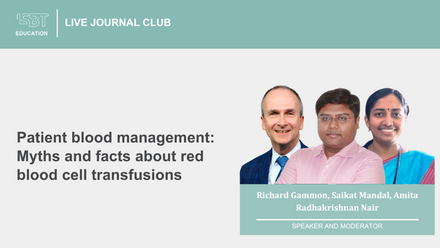The Blood Stop and Go session included the following presentations:
1. Tor Audun Hervig: Pre-Hospital Use of Blood Products
2. Saif Ali: A large multicentre evaluation of massive hemorrhage protocol performance and compliance across adult and pediatric hospitals
3. Laura Green: Massive transfusion - can we agree on a definition?
4. Sakara Hutspardol: Comparison of ROTEM and Conventional Coagulation Tests in Identifying Trauma-Induced Coagulopathy During Massive Hemorrhage Protocol
5. Helen Elizabeth Haysom: Did critically bleeding RhD negative patients receive RhD matched RBCs? Data from the Australian and New Zealand Massive Transfusion Registry
MODERATORS: Arwa Al-Riyami and Jouni Lauronen
After the presentation, there was a questions and answers session of about 5 minutes, which is also included in the recording.
Abstract
Comparison of ROTEM and conventional coagulation tests in identifying trauma-induced coagulopathy during massive haemorrhage protocol
S Hutspardol1,2, T Borja3, J Kroeker4, X Wang2, J Mi1, G Chan1, H Yeh1, T Smith1,2,5, H Hawes4, A Shih1,2,5
1Department of Pathology and Laboratory Medicine, Vancouver Coastal Health, 2Department of Pathology and Laboratory Medicine, 3University of British Columbia, Vancouver, Canada, 4Division of General Surgery, Trauma and Acute Care Surgery, Vancouver General Hospital, 5Centre for Blood Research, University of British Columbia, Vancouver, Canada
Background: Trauma-induced coagulopathy (TIC) resulting from massive haemorrhage can be fatal but preventable if recognised early. Evidence has shown that viscoelastic haemostatic assays, such as rotational thromboelastometry (ROTEM), are sensitive and guide goal-directed transfusion; but comparatively expensive leading to limited availability. With its emerging use in trauma, we believe ROTEM can identify TIC more rapidly than conventional coagulation tests (CCTs).
Aims: We evaluated TIC-defining parameters using the ROTEM and CCT results at Vancouver General Hospital (VGH), the primary trauma centre in British Columbia, Canada, to determine their correlation with blood component utilisation and clinical outcomes during trauma-based massive haemorrhage protocol (MHP) activations.
Methods: This was a retrospective observational study of trauma patients who received transfusion as per 1:1:1 ratio-based MHP at VGH from June 1, 2020, to May 31, 2022. Patient characteristics, CCT and ROTEM results, transfusion data and 24-h and 28-day mortalities were collected from patient and blood bank disposition records. We defined TIC based on institutional algorithms using ROTEM and CCT transfusion triggers in the MHP, including (A) ROTEM-based results of Extem A10 < 40 mm, Extem CT > 100 s, Extem maximum lysis (ML) > 10%, Fibtem A10 < 10 mm; and (B) CCT-based results of INR > 1.8, PTT > 1.5 times of upper normal limit, platelets < 50 × 109/L, and Clauss fibrinogen level < 1.5 g/L. Lab findings of TIC were assessed for their correlation with blood component utilisation and mortality using univariate analysis. Continuous variables were compared by using an independent t-test.
Results: Sixty-eight patients had CCT and ROTEM testing performed during a trauma MHP. Thirty-one patients (46%) did not have TIC defined by initial CCT and/or ROTEM results. Twenty-four patients (35%) presented with abnormal ROTEM alone, and 13 patients (19%) had both abnormal CCTs and ROTEM. Of 55 patients with no additional blood components suggested by CCTs, the median number of red blood cells (RBC), frozen plasma (FP), platelet units, and grams of fibrinogen concentrate (FC) transfused within the first 4 hours of MHP was significantly higher in those who had abnormal initial ROTEM (median RBC: 7.8 vs. 4.3, FP: 5.5 vs. 2.6, platelets: 1.3 vs. 0.4, FC: 4.2 vs. 1.4; p < 0.05).
Comparing fibrinogen results between ROTEM and CCT, 20 of 68 patients (29%) had hyperfibrinogenaemia based on fibrinogen < 1.5 g/L by CCTs versus 30 of 68 patients (49%) had hyperfibrinogenaemia based on ROTEM within the first 24 h of MHP activation. Those with hyperfibrinogenaemia per CCT had significantly higher 24-h and 28-day mortalities compared to patients with fibrinogen > 1.5 g/L [24 h: 6/20 (30%) vs. 4/48 (8%), p = 0.028; 28 days: 11/20 (55%) vs. 8/48 (17%), p = 0.001]. However, those with hyperfibrinogenaemia based on ROTEM Fibtem A10 had no significant difference in 24-h and 28-day mortalities [24 h: 6/33 (18%) vs. 4/35 (11%), p = 0.507; 28 days: 10/33 (30%) vs. 9/35 (26%), p = 0.673], but had significantly higher transfusion requirements within the first 4 and 24 h of MHP compared to the normal Fibtem A10 group.
Finally, all blood component requirements within the first 4 h of MHP were significantly higher in patients with a CCT fibrinogen level of 1.5–1.9 compared to those >1.9 g/L (p-values < 0.05).
Summary/Conclusions: ROTEM, particularly FIBTEM A10, was more sensitive in identifying hyperfibrinogenaemia and TIC than CCTs. There was a significant association between increased blood component usage in patients with TIC defined by ROTEM but not by CCTs, and Clauss fibrinogen < 1.9 g/L. Thus, TIC identified by ROTEM and higher cut-offs for Clauss fibrinogen may be more sensitive indicators for transfusion, which could benefit patient outcomes, but this requires further study.






